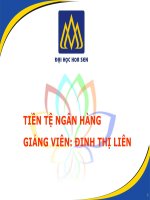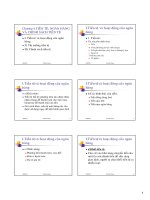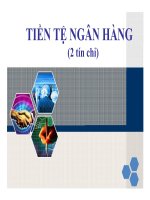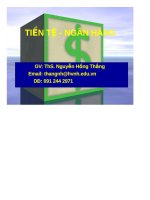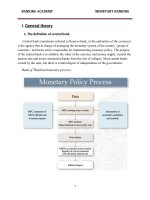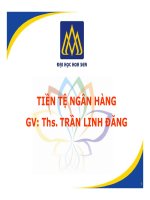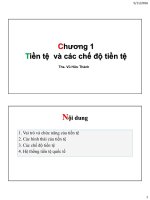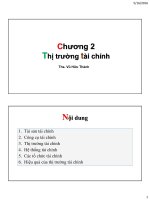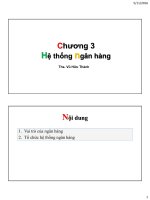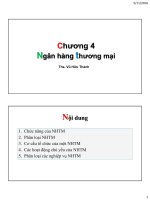Bài giảng Tiền tệ, ngân hàng và thị trường tài chính 1 - Chương 8: Ngân hàng thương mại
Bạn đang xem bản rút gọn của tài liệu. Xem và tải ngay bản đầy đủ của tài liệu tại đây (1.32 MB, 60 trang )
BỘ MƠN TÀI CHÍNH – TIỀN TỆ
CHƯƠNG 8
NGÂN HÀNG
THƯƠNG M I
FINANCE - MONETARY DEPARTMENT
CHAPTER 8
COMMERCIAL BANK
179
CHU N Đ U RA
Sau khi học xong chương này, người học có thể
1.
Giải thích được bản chất của ngân hàng thương mại.
2.
Giải thích được các dịch vụ chính mà NHTM cung cấp cho người gửi tiền và
người vay tiền.
3.
Giải thích được các khoản mục cơ bản trên báo cáo tài chính của NHTM
4.
Thành thạo các việc tính tốn lãi suất tiền gửi, tiền vay.
LEARNING OUTCOMES
1. Be able to explain what a bank is.
2. Be able to explain the core banking services that bank offer to their
deposit and loan customers.
3. Be able to explain the core items of bank balance sheet.
4. Be able to do the basic calculation of interest on loan, on deposit.
180
NGÂN HÀNG THƯƠNG M I VÀ CÁC DỊCH VỤ CƠ BẢN
Ngân hàng thương mại:
- Định chế tài chính mà cung cấp các dịch vụ nhận tiền gửi và cho vay.
Ngân hàng thương mại huy động vốn bằng cách:
- cung cấp các dịch vụ tiền gửi khác nhau gồm: Tiền gửi thanh tốn, Tiền gửi tiết kiệm và
tiền gửi có kỳ hạn.
Ngân hàng thương mại sử dụng vốn đã huy động để:
- Cho vay dưới nhiều hình thức khác nhau: cho vay tiêu dùng, cho vay thương mại, cho
vay thế chấp bất động sản.
- Đầu tư vào trái phiếu chính phủ.
Ngân hàng thương mại cung cấp 3 dịch vụ tài chính cơ bản sau:
- Thanh toán
- Tiền gửi (thực hiện chức năng trung gian tài chính)
- Tín dụng (thực hiện chức năng trung gian tài chính)
Ngân hàng thương mại cũng cung cấp những dịch vụ tài chính khác như:
- Các hoạt động ngoại bảng (ví dụ: bảo lãnh tín dụng)
- Bảo hiểm
- Tín thác
PART
01
COMMERCIAL BANK AND
CORE SERVICES
Commercial banks:
- Financial institutions that accept deposits and make loans.
Commercial bank raise funds primarily by issuing:
- Checkable deposits (deposits on which checks can be written), savings
deposits (deposits that are payable on demand but do not allow their owner to
write checks), and time deposits (deposits with fixed terms to maturity).
Commercial bank use these funds:
- To make commercial, consumer, and mortgage loans
- To buy government securities and municipal bonds.
Banks provide three core banking services:
- Payment
- Deposit function (financial intermediation)
- Loan function (financial intermediation)
Banks may also offer other financial services:
- Off balance sheet activities
- Insurance and securities related activities
- Trust services
181
CHỨC NĂNG THANH TỐN
Thanh tốn khơng dùng tiền mặt
Check _ Séc
Là một lệnh ghi nhận bằng văn bản
trong đó hướng dẫn Ngân hàng lập
tức thanh toán một số tiền cụ thể từ
tài khoản thanh toán của người viết
séc cho một người thụ hưởng có tên
trên séc hoặc cho một người cụ thể
mà mang séc đến Ngân hàng để yêu
cầu thanh tốn (bearer).
PART
01
Chuyển tiền
• Dịch vụ chuyển tiền
• Thanh tốn điện tử song phương giữa các
ngân hàng.
BASIC PAYMENT
FUNCTION
Payments function
Check
A written order instructing a
bank to pay immediately on
demand a specified amount of
money from the check writer's
account to the person named
on the check or, if a specific
person is not named, to
whoever bears the check to the
institution for payment.
Payment without cash
Money remittance
Money transfer services
Electronic bilateral interbank payment
182
CHỨC NĂNG THANH TỐN
Thẻ ngân hàng
• Phát hành bởi Ngân hàng
thương mại hoặc cơng ty
tài chính.
• Được sử dụng để rút tiền
từ ATM.
• Được sử dụng thanh
tốn tiền mua hàng hóa,
dịch vụ online hoặc qua
POS.
PART
01
Bank card
• Issued by a bank or a
financial company
• Used to obtain cash
from automated teller
machines
• Used to purchase
goods or services
using point-of-sale &
online purchases
easily locally &
overseas
Thẻ ghi nợ
• Kết nối trực tiếp với tiền
trong tài khoản thanh
tốn.
• Chỉ được thanh tốn
trong giới hạn số dư có
trong tài khoản thanh
tốn.
• Khơng tính lãi.
• Thấu chi: có thể rút tiền
hoặc thanh tốn vượt q
số dư có trong tài khoản
thanh tốn.
• Ưu điểm: Tránh được
việc chi tiêu q mức
Thẻ tín dụng
• Chủ thẻ vay tiền từ ngân hàng
và hồn trả một phần hồn tồn
bộ số tiền đã vay hằng tháng.
• Hạn mức tín dụng: Số tiền tối
đa được phép sử dụng từ thẻ tín
dụng.
• Thẻ tín dụng áp dụng chính
sách miễn lãi sẽ được áp dụng
cho 1 kỳ hạn nhất định (có thể
lên đến 45 ngày). Sau thời hạn
này, chính sách tính lãi sẽ bắt
đầu áp dụng chủ thẻ khơng
hồn trả đầy đủ số dư tín dụng.
• Ưu điểm: mua hàng ngay cả khi
bạn khơng có tiền tại thời điểm
mua.
BASIC PAYMENT
FUNCTION
Debit Card
• Access money directly
from current account.
• Access only as much
money as available in
current account
• No interest charges.
• Overdraft: be able to
withdraw or spend
more than the amount
actually available in
the current account
• Advantage: help to
curb overspending
183
Credit card
• Cardholder borrows money
from bank and payback
some or all of borrowed
money each months.
• Having a credit limit: The
maximum amount of credit
that is available.
• Charging interest if
cardholder doesn’t pay off
credit in full.
• Interest free for a specified
period (up to 45 days)
• Advantage: make purchase
even if you don’t available
funds at the time of the
purchase.
CHỨC NĂNG NHẬN TIỀN GỬI
Chức năng nhận tiền gửi: huy động tiền gửi từ công chúng thông qua nhiều phương
thức khác nhau:
• Gửi tiền vào tài khoản thanh tốn
• Gửi tiết kiệm
• Gửi tiền có kỳ hạn
Tiền gửi vào Tài khoản thanh tốn: thường khơng tính lãi
Tiền gửi vào Tài khoản tiết kiệm: có tính lãi nhưng lãi suất thấp hơn lãi áp dụng cho
tiền gửi có kỳ hạn cố định.
Lãi được tính hằng ngày và thanh tốn hằng tháng hoặc vào thời điểm đáo hạn.
Các tài khoản này đều có thể truy cập được thơng qua các dịch vụ như phone
banking, dịch vụ ngân hàng trực tuyến, hệ thống ATM và tại các quầy giao dịch của
ngân hàng.
/>
PART
01 DEPOSIT FUNCTION
Deposit function: receive or collect deposits from the public in different
forms of accounts:
• Current account (checking account)
• Savings account
• Term deposits.
No interest is charged in the current account, lower rate of interest is
charged in the savings account and a comparatively higher interest rates
charged in fixed deposits.
Interest calculated daily and paid monthly or at maturity
Access to phone banking, online banking services, ATM network and
office banks
/>
184
CHỨC NĂNG NHẬN TIỀN GỬI
Tài khoản thanh toán
▪ Tài khoản thanh toán cho phép khách hàng gửi tiền, rút tiền và viết séc.
▪ Tài khoản thanh tốn giúp cịn cho phép quản lý tiền mỗi ngày thông qua nhiều tiện ích,
tiêu bểu như các phương thức thanh toán linh hoạt sau đây:
• Sổ séc
• Thẻ ghi nợ
• Thấu chi
• Tiện ích khác
▪ Không tính lãi trên số dư tiền gửi trong tài khoản thanh toán.
Tài khoản tiết kiệm (Sổ tiết kiệm)
▪ Tài khoản ngân hàng cho phép khách hàng gửi tiền vào bất cứ thời điểm nào nhằm
mục đích tiết kiệm và hưởng lãi.
▪ Tiền trong tài khoản tiết kiệm có thể gửi thêm hoặc rút ra linh hoạt ở bất cứ thời điểm
nào.
▪ Khách hàng cũng có thể gửi tiết kiệm định kì.
▪ Lãi suất áp dụng cho số dư trong tài khoản tiết kiệm thường là lãi suất thả nổi.
PART
01 DEPOSIT FUNCTION
Checking account
▪ A bank account that allows a customer to deposit and withdraw money and
write checks.
▪ A deposit account offering day-to-day money management facilities such
as various flexible payment methods:
• Check book
• Debit card
• Overdraft
• Others
▪ No interest is charged in the current account
Savings account ( Passbook)
▪ A simple bank account that allow a customer to deposit at any time to save
money and to earn interest.
▪ Funds can be transferred in and out anytime (more flexible and accessible
than a term deposit)
▪ Customers can also make regular deposits to a savings.
▪ Savings account has generally a variable interest rate.
185
CHỨC NĂNG NHẬN TIỀN GỬI
Tài khoản tiền gửi có kỳ hạn: (Tiền gửi có kỳ hạn, chứng chỉ tiền gửi)
•
u cầu số tiền tối thiểu khi mở tài khoản.
•
Khơng rút tiền trong trước kỳ hạn. Trong một số trường hợp vẫn được rút tiền trước
hạn nhưng có báo trước đồng thời chịu phí phạt.
•
Tiền khi đến hạn có thể được rút ra hoặc tái tục thêm 1 kỳ hạn nữa.
•
Áp dụng lãi suất cố định tương ứng với kỳ hạn gửi.
•
Kỳ hạn gửi tiền càng dài thì sinh lợi càng cao.
Tiền gửi có kỳ hạn và tiền gửi tiết kiệm có thể dùng như tài sản đảm bảo cho các khoản
vay trong ngân hàng.
PART
01 DEPOSIT FUNCTION
Term Deposit account: (time deposit - certificates of deposit)
• Minimum amount deposit to open the account.
• No withdrawal of funds during the term of the deposit, often requires a
notice of withdrawal and penalties are imposed for early withdrawal;
• When the term is over it can be withdrawn, or it can be held for another
term.
• Pays a fixed interest rate for a set term.
• The longer the term, the better the yield on the money.
Time Deposit Account and Savings Deposit can be used as collateral or
guarantee for loans at the Bank
186
CHỨC NĂNG NHẬN TIỀN GỬI
Nguyên tắc tính lãi cho tiền gửi tiết kiệm và tiền gửi có kỳ hạn:
✓ Tính lãi phải trả khi đáo hạn bằng cơng thức tính lãi đơn
Tiền lãi =
ề
ố × ã
ấ
à × ố
à
ử
ề
Ví dụ: Khách hàng gửi $1,000 kỳ hạn 6 tháng (tương ứng 184 ngày), lãi suất là
5.0%/năm.
Thanh toán tiền gốc và tiền lãi một lần khi hết hạn.
Số tiền thanh toán bằng $1,025.21
ề
ã = $1,000 ×
. %
× 184 = $25.21
PART
01 DEPOSIT FUNCTION
Basic principles for calculating interest on passbook savings and term
deposits
✓ To calculate interest for term deposits when interest is paid at maturity:
Calculation of simple Interest
=
×
×
Example: Client deposits $1,000 for six months (184 days) with annual
interest rate of 5.0%. The payout, including principal and interest, at the end
of six months is $1,025.21
= $1,000 ×
. %
187
× 184 = $25.21
CHỨC NĂNG NHẬN TIỀN GỬI
Nguyên tắc tính lãi cho tiền gửi tiết kiệm và tiền gửi có kỳ hạn:
✓ Tính lãi phải trả bằng cơng thức tính lãi kép
ề
ã =
ề
ố ×( + ã
ấ)
ố ỳ ạ
í
ã
− ê
ơ
Ví dụ: Khách hàng gửi $1,000 kỳ hạn 6 tháng, lãi suất là 5.0%/năm. Khi đến hạn, số tiền
thanh toán gồm cả gốc lẫn lãi là: $1,025.21.
ề
ã = $1,000 × (1 +
%
) - 1,000 = $25.26
PART
01 DEPOSIT FUNCTION
✓ To calculate interest on term deposits compounding the interest:
Calculation of compound Interest
=
×( +
)
−
Example: Client deposits $1,000 for six months with annual interest rate of
5.0%. The payout, including principal and interest, at the end of six months is
$1,025.21
= $1,000 × (1 +
188
%
) - 1,000 = $25.26
CHỨC NĂNG NHẬN TIỀN GỬI
Q1. Tính và so sánh tiền lãi nhận được từ hai phương án sau:
-
gửi $2 000, tính lãi đơn, lãi suất 6$/năm.
-
gửi $2 000, tính lãi kép, lãi tính theo ngày, lãi suất 6$/năm.
Q2. So sánh hai phương án gửi tiền sau đây:
-
Gửi tiền, lãi suất 4.9%/năm, tính lãi kép, tính lãi 6 tháng 1 lần.
-
Gửi tiền, lãi suất 4.9%/năm, tính lãi kép, tính lãi theo ngày.
PART
01 DEPOSIT FUNCTION
Q1. Will you earn more interest in one year by depositing
$2000 in a simple interest account that pays 6% per year or
in an account that pays 6.% per year interest compounded
daily? How much more interest will you earn?
Q2. A bank offers a money market account paying 4,9%
interest compounded semiannually. A competing bank offers
a money market account paying 4.9% interest compounded
daily. Which account is the better investment?
189
CHỨC NĂNG NHẬN TIỀN GỬI
Q3. Khách hàng A gửi $3.000, lãi suất 3.5%/năm, tính lãi kép định kỳ hằng
năm. Khách hàng B gửi $2.500, lãi suất 4.8%/năm tính lãi kép định kỳ hằng
tháng.
A. Khách hàng nào có nhiều tiền hơn sau 1 năm? Nhiều hơn bao nhiêu?
B. Khách hàng nào có nhiều tiền hơn sau 5 năm? Nhiều hơn bao nhiêu?
C. Khách hàng nào có nhiều tiền hơn sau 20 năm? Nhiều hơn bao nhiêu?
Q4. Một khách hàng gửi tiết kiệm $6.000, lãi suất 5%/năm, tính
lãi kép định kỳ 6 tháng. Đến đầu năm thứ 3, khách hàng đó gửi
thêm $4.000. Vậy, cuối năm thứ 6, số dư tài khoản tiết kiệm của
khách hàng này là bao nhiêu?
PART
01 DEPOSIT FUNCTION
Q3. You deposit $3,000 in an account that pays 3.5% per
year interest compounded once a year. Your friend deposits
$2,500 in an account that pays 4.8% interest compounded
monthly.
A. Who will have more money in their account after one
year? How much more?
B. Who will have more money in their account after five
years? How much more?
C. Who will have more money in their account after 20
years? How much more?
Q4. A depositor opens a new savings account with $6.000 at
5% per year compounded semiannually. At the beginning of
the year 3, an additional $4.000 is deposited. At the end of
six years what is the balance in the account?
190
CHỨC NĂNG TÍN DỤNG
Tín dụng là hoạt động chính của Ngân hàng thương mại và là kênh sinh lợi chính của
Ngân hàng thương mại.
Cho vay trả góp
- Đây là một trong những phương thức cho vay thương mại đơn giản và phổ biến nhất.
Cho vay theo hạn mức tín dụng
-
Tính chất cũng tương tự như thẻ tín dụng
-
Người vay được sử dụng vốn vay trong một hạn mức tín dụng nhất định.
PART
01
LOAN FUNCTION
Loans are the primary use of bank’s funds and the principal way in which
they earn income
Installment Loans
One of the most straightforward and most popular commercial loan products
is installment loans. Once approved, a business receives all of their funds at
one time and begins making payments. The amount owed is a calculation of
the principal (actual amount borrowed) plus interest and any fees or other
charges applied to the loan. The lender and borrower agree to a term (how
long it takes to pay back) and other conditions.
Lines of Credit
Lines of credit function similarly to how a consumer might think of a credit
card. When a business needs funds and has an approved business line of
credit, they can contact the bank and receive money almost immediately(as
long as their requested amount is within the limits of their credit line)
191
CHỨC NĂNG TÍN DỤNG
Những sản phẩm/dịch vụ tín dụng khác, trong thực tế,:
Cho vay đầu tư thiết bị (Equipment Loans): Vốn vay được xác định sử dụng
cho một mục tiêu cụ thể, như mua hệ thống dây chuyền sản xuất.
Các khoản cho vay đối với chương trình hỗ trợ SBA:
-
được bảo lãnh bởi Chính phủ Hoa Kỳ.
-
Vốn vay được sử dụng cho mục tiêu phát triển nông nghiệp hoặc các chương
trình phát triển nhà nội thành
Các khoản tín dụng ứng trước:
-
Ứng trước vốn qua thẻ tín dụng.
PART
01
LOAN FUNCTION
Other Types
There are several other types of commercial loans that a business
might have access to, including:
Equipment Loans: These are installment loans that are made
specifically to purchase or refinance a piece of equipment, like a
bulldozer or a pizza oven. The funds are tied directly to the purchase of
that equipment and may not be used for any other purpose.
SBA Loans: While not necessarily a type of loan, Small Business
Administration (SBA) loans are backed by the United States
government and offer funding for very specific purposes like
agricultural development or inner-city housing programs.
Merchant Cash Advances: Businesses that accept credit and debit
cards may be eligible to borrow funds with the promise of paying them
back from their future card revenues.
192
BẢNG CÂN ĐỐI KẾ TOÁN CỦA
NGÂN HÀNG THƯƠNG M I
Bảng cân đối kế toán thể hiện tất cả tài sản và nguồn vốn mà Ngân hàng có, trong đó:
Tổng tài sản = Tổng vốn huy đơng + Vốn tự có
Bảng cân đối kế toán phản ánh tất cả các nguồn vốn cũng như việc sử dụng nguồn vốn
đó.
Vốn huy động
Các tài sản
Ngân hàng huy động vốn thông qua
nhiều kênh, từ phát hành và bán các
chứng khoán cũng như cung cấp các
dịch vụ tiền gửi, thanh toán…
PART
02
Ngân hàng sử dụng vốn huy động được
để đầu tư vào các kênh sinh lợi.
BANK BALANCE SHEET
The bank balance sheet a list of the bank’s assets and liabilities, it has the
characteristic that:
total assets = total liabilities + capital
A bank’s balance sheet lists sources of bank funds (liabilities) and uses to
which they are put (assets).
Liabilities
Assets
A bank acquires funds by issuing
(selling) liabilities, which are
consequently also
referred to as sources of funds.
The funds obtained from issuing
liabilities are used to
purchase income-earning assets.
A bank uses the funds that it has
acquired by issuing liabilities to
purchase income earning
assets. Bank assets are thus
naturally referred to as uses of
funds, and the interest
payments earned on them are what
enable banks to make profits.
193
BẢNG CÂN ĐỐI KẾ TOÁN CỦA
NGÂN HÀNG THƯƠNG M I
Tài sản
Nguồn vốn
•
Tiền gửi thanh tốn
•
Dự trữ
•
Tiền gửi khơng giao dịch
•
Tiền mặt
(Nontransaction Deposits)
•
Tiền gửi tại ngân hàng khác
•
Tiền vay
•
Chứng khốn
•
Vốn tự có
•
Tín dụng
•
Tài sản khác
PART
02
BANK BALANCE SHEET
Liabilities
Assets
•
Checkable deposits
•
Reserves
•
Non-transaction deposits
•
Cash items in process of collection
•
Borrowings
•
Deposits at other banks
•
Bank capital
•
Securities
•
Loans
•
Other assets
194
BẢNG CÂN ĐỐI KẾ TOÁN CỦA
NGÂN HÀNG THƯƠNG M I
Bảng cân đối kế toán của các ngân hàng thương mại Mỹ
(Đơn vị: %, số liệu thống kê cuối năm 2004)
Tài sản (sử dụng vốn)*
Nguồn vốn
Dự trữ và tiền mặt
1 Tiền gửi thanh tốn
Chứng khốn
9
Tiền gửi khơng giao dịch
Chứng khốn Chính phủ
15
Chứng khốn khác
Tiền gửi có kỳ hạn, mệnh giá nhỏ
8
Cho vay
Cho vay thương mại và công nghiệp
(<$100,000) + tiền gửi tiết kiêm
46
Tiền gửi có kỳ hạn mệnh giá lớn
15
8 Tiền vay
Cho vay bất động sản
29 Vốn chủ sở hữu
Cho vay liên ngân hàng
16
Cho vay khác
24
6
3
Tài sản khác (ví dụ: Trụ sở, thiết bị… )
Tổng cộng
20
100 Tổng cộng
100
*Các khoản mục được sắp xếp theo tính thanh khoản từ cao xuống thấp
/>
PART
02
Table 1
BANK BALANCE SHEET
Balance Sheet off All Commercial Banks (items as a percentage of the total, end of 2004,
amounts in billions dollars)
Assets (Uses of Funds)*
Reserves and cash items
Liabilities (Sources of Funds)
1
Securities
U.S government and agency
State and local government and orther
securities
15
8
8
Real estate
29
Inter bank
16
Orther
Orther assets (for example, physical capital
Total
9
Nontransaction depostits
Loans
Commerical and industrial
Checkable deposits
Small-denomination time deposits
(<$100,000) + savings deposits
46
Large-denomination time deposits
15
Borrowing
Bank capital
24
6
3
20
100
Total
100
*In order of decreasing liquidity.
/>
195
NGUỒN VỐN CỦA NGÂN HÀNG
THƯƠNG M I
Tiền gửi thanh toán:
- Chi phí vốn thấp nhất.
Tiền gửi khơng giao dịch (Nontransaction Deposits_
- Nguồn vốn chính của ngân hàng (chiếm tỷ lệ đến 61% ở NH Mỹ)
- Chi phí vốn cao nhất.
PART
02
LIABILITIES
Checkable Deposits: includes all accounts that allow the owner (depositor)
to write checks to third parties; examples include non-interest earning
checking accounts (known as DDAs—demand deposit accounts), interest
earning negotiable orders of withdrawal (NOW) accounts, and money-market
deposit accounts (MMDAs), which typically pay the most interest among
checkable deposit accounts
Checkable deposits are a bank’s lowest cost funds because depositors want
safety and liquidity and will accept a lesser interest return from the bank in
order to achieve such attributes
Nontransaction Deposits: are the overall primary source of bank liabilities
(61%) and are accounts from which the depositor cannot write checks;
examples include savings accounts and time deposits (also known as CDs or
certificates of deposit)
Nontransaction deposits are generally a bank’s highest cost funds because
banks want deposits which are more stable and predictable and will pay more
to the depositors (funds suppliers) in order to achieve such attributes
196
NGUỒN VỐN CỦA NGÂN HÀNG
THƯƠNG M I
Vốn vay:
- Vay từ Ngân hàng trung ương (vay chiết khấu)
- Vay từ các ngân hàng thương mại khác (vay bù trừ tài khoản giữa các ngân hàng)
- Vay từ các công ty và nhà đầu tư khác (thương phiếu, giấy tờ có giá khác)
Lưu ý: Một số khoản vay có thể biến động hơn các nguồn vốn khác, tùy thuộc vào điều
kiện thị trường.
Vốn chủ sở hữu:
- Cổ phần
- Thu nhập giữ lại.
Lưu ý: Vốn chủ sở hữu đóng vai trị quan trọng trong ngân hàng.
- Còn được gọi là “shock absorter”
- Bảo vệ các nhà đầu tư, người gửi tiền… trước sự giảm giá hoặc mất giá tài sản của
ngân hàng.
PART
02
LIABILITIES
Borrowings: banks obtain funds by borrowing from the Federal Reserve
System, other banks, and corporations; these borrowings are called:
discount loans/advances (from the Fed), fed funds (from other banks),
interbank offshore dollar deposits (from other banks), repurchase
agreements (a.k.a., “repos” from other banks and companies), commercial
paper and notes (from companies and institutional investors)
Certain borrowings can be more volatile than other liabilities, depending on
market conditions
Bank Capital: is the source of funds supplied by the bank owners, either
directly through purchase of ownership shares or indirectly through retention
of earnings (retained earnings being the portion of funds which are earned
as profits but not paid out as ownership dividends)
Since assets minus liabilities equals capital, capital is seen as protecting the
liability suppliers from asset devaluations or write-offs (capital is also called
the balance sheet’s “shock absorber,” thus capital levels are important)
197
HO T ĐỘNG CƠ BẢN CỦA NGÂN HÀNG
Giới thiệu 1 ví dụ đơn giản về hoạt động của ngân hàng, phản ánh qua Bảng cân đối kế
toán.
Tài khoản chữ T: nhận $100 tiền gửi bằng tiền mặt vào Ngân hàng First National
NGÂN HÀNG FIRST NATIONAL
Tài sản
Tiền tại quỹ
Nguồn vốn
+$100
PART
02
Tài khoản thanh toán
+$100
BASICS OF BANKING
Before we explore the main role of banks—that is, asset transformation, it is
helpful to understand some of the simple accounting associated with the
process of banking.
T-account Analysis: Deposit of $100 cash into First National Bank
Assets
Vault
FIRST NATIONAL BANK
Liabilities
+$100
Checkable deposits
198
+$100
HO T ĐỘNG CƠ BẢN CỦA NGÂN HÀNG
Nhận tiền gửi bằng séc $100
NGÂN HÀNG FIRST NATIONAL
Tài sản
Nguồn vốn
Tiền mặt đang thu +$100
Tiền gửi thanh toán
NGÂN HÀNG FIRST NATIONAL
Tài sản
Dự trữ
NGÂN HÀNG SECOND NATIONAL
Nguồn vốn
+$100
Tiền gửi
+$100
Tài sản
+$100
Dự trữ
Nguồn vốn
-$100
Tiền gửi
-$100
Kết luận: Khi ngân hàng nhận tiền gửi, dự trữ tăng lên một khoản tương ứng và
ngược lại.
PART
BASICS OF BANKING
02
Deposit of $100 check
Assets
FIRST NATIONAL BANK
Cash items in process of collection
+$100
Checkable deposits
FIRST NATIONAL BANK
Assets
Reserves
+$100
+$100
SECOND NATIONAL BANK
Liabilities
Deposits
Liabilities
Assets
+$100
Reserves
-$100
Liabilities
Deposits
-$100
Conclusion: When bank receives deposits, reserves by equal amount;
when bank loses deposits, reserves by equal amount
199
HO T ĐỘNG CƠ BẢN CỦA NGÂN HÀNG
Phân tích tài khoản chữ T: tình huống khách hàng gửi $100 tiền mặt. Tỷ lệ dự trữ
bắt buộc 10%.
NGÂN HÀNG FIRST NATIONAL
Tài sản
Dự trữ bắt buộc
Dự trữ vượt mức
PART
Nguồn vốn
+$10
+$90
Tiền gửi thanh toán
+$100
BASICS OF BANKING
02
This simple analysis gets more complicated when we add bank regulations
to the picture. For example, if we return to the $100 deposit, recall that
banks must maintain reserves, or vault cash. This changes how the $100
deposit is recorded.
T-account Analysis
Deposit of $100 cash into First National Bank
FIRST NATIONAL BANK
Assets
Required reserves
Excess reserves
Liabilities
+$100
+$90
Checkable deposits
+$100
As we can see, $10 of the deposit must remain with the bank to meeting
federal regulations. Now, the bank is free to work with the $90 in its asset
transformation functions. In this case, the bank loans the $90 to its
customers.
200
HO T ĐỘNG CƠ BẢN CỦA NGÂN HÀNG
Phân tích tài khoản chữ T: tình huống khách hàng gửi $100
tiền mặt. Tỷ lệ dự trữ bắt buộc 10%. Ngân hàng sử dụng
$90 để cho vay
FIRST NATIONAL BANK
Tài sản
Dự trữ bắt buộc
Cho vay
PART
02
Nguồn vốn
+$10
+$90
Tiền gửi thanh toán
+$100
BASICS OF BANKING
As we can see, $10 of the deposit must remain with the bank to
meeting federal regulations. Now, the bank is free to work with the $90
in its asset transformation functions. In this case, the bank loans the
$90 to its customers.
T-account Analysis:
Deposit of $100 cash into First
National Bank
FIRST NATIONAL BANK
Assets
Required reserves
Loans
Liabilities
+$100
+$90
201
Checkable deposits
+$100
TÀI SẢN CỦA NGÂN HÀNG THƯƠNG M I
Ngân hàng sử dụng các nguồn vốn đã huy động được cho các mục tiêu sinh lợi.
Dự trữ (Reserves). Một phần tiền gửi của Ngân hàng thương mại phải đưa vào tài
khoản dự trữ bắt buộc mở tại Ngân hàng trung ương, theo luật định.
Dự trữ bắt buộc (required reserves).
Dự trữ vượt mức (excess reserves)
PART
02
ASSETS
A bank uses the funds that it has acquired by issuing liabilities to purchase
income earning assets. Bank assets are thus naturally referred to as uses of
funds, and the interest payments earned on them are what enable banks to
make profits.
Reserves. Regulation making it obligatory for depository institutions to keep
a certain fraction of their deposits in accounts with the Fed.
First, some reserves, called required reserves, are held because of reserve
requirements, the regulation that for every dollar of checkable deposits at a
bank, a certain fraction (10 cents, for example) must be kept as reserves.
This fraction (10 percent in the example) is called the required reserve
ratio.
Banks hold additional reserves, called excess reserves, because they are
the most liquid of all bank assets and can be used by a bank to meet its
obligations when funds are withdrawn, either directly by a depositor or
indirectly when a check is written on an account.
202
TÀI SẢN CỦA NGÂN HÀNG THƯƠNG M I
Tiền mặt đang thu:
- Nguồn thu từ các khoản thanh toán qua séc được xếp vào nhóm tiền mặt đang thu
vì nó sẽ được thực hiện trong 1 vài ngày.
Tiền gửi tại ngân hàng thương mại khác
-
Nhiều ngân hàng nhỏ thường gửi 1 phần tiền vào các ngân hàng lớn để duy trì các
dịch vụ như: thanh toán séc, giao dịch ngoại hối, mua chứng khoán (correspondent
banking).
Dự trữ, tiền mặt đang thu và tiền gửi tại các ngân hàng khác được phân loại vào
nhóm thanh khoản cao, gọi là tiền mặt.
Chứng khốn
Ngân hàng nắm giữ chứng khoán như một kênh đầu tư sinh lợi.
PART
02
ASSETS
Cash Items in Process of Collection
The check is classified as a cash item in process of collection, and it is an
asset for your bank because it is a claim on another bank for funds that will
be paid within a few days.
Deposits at Other Banks
Many small banks hold deposits in larger banks in exchange for a variety of
services, including check collection, foreign exchange transactions, and help
with securities purchases. This is an aspect of a system called
correspondent banking.
Collectively, reserves, cash items in process of collection, and deposits at
other banks are often referred to as cash items
Securities
A bank’s holdings of securities are an important income-earning asset
203
